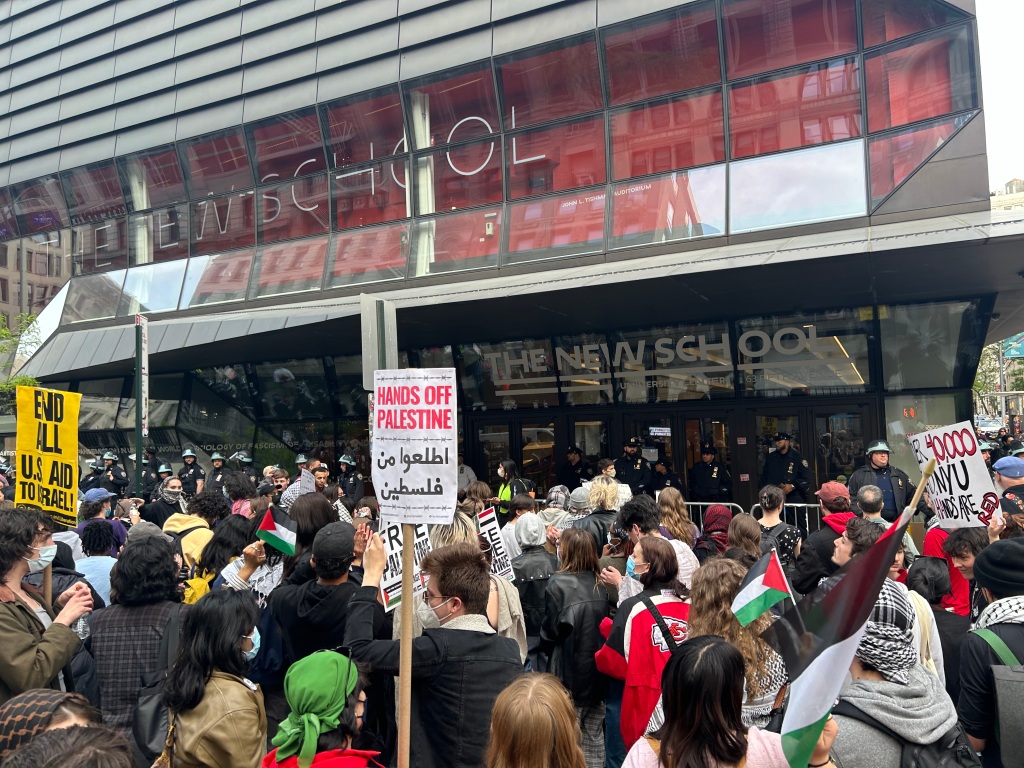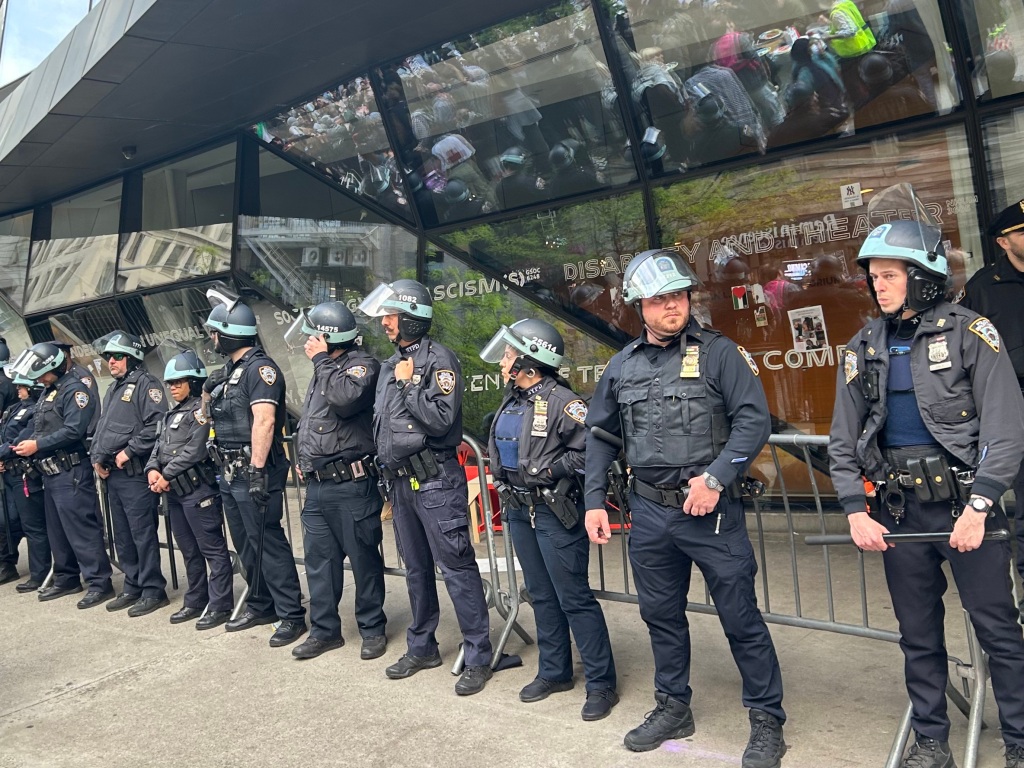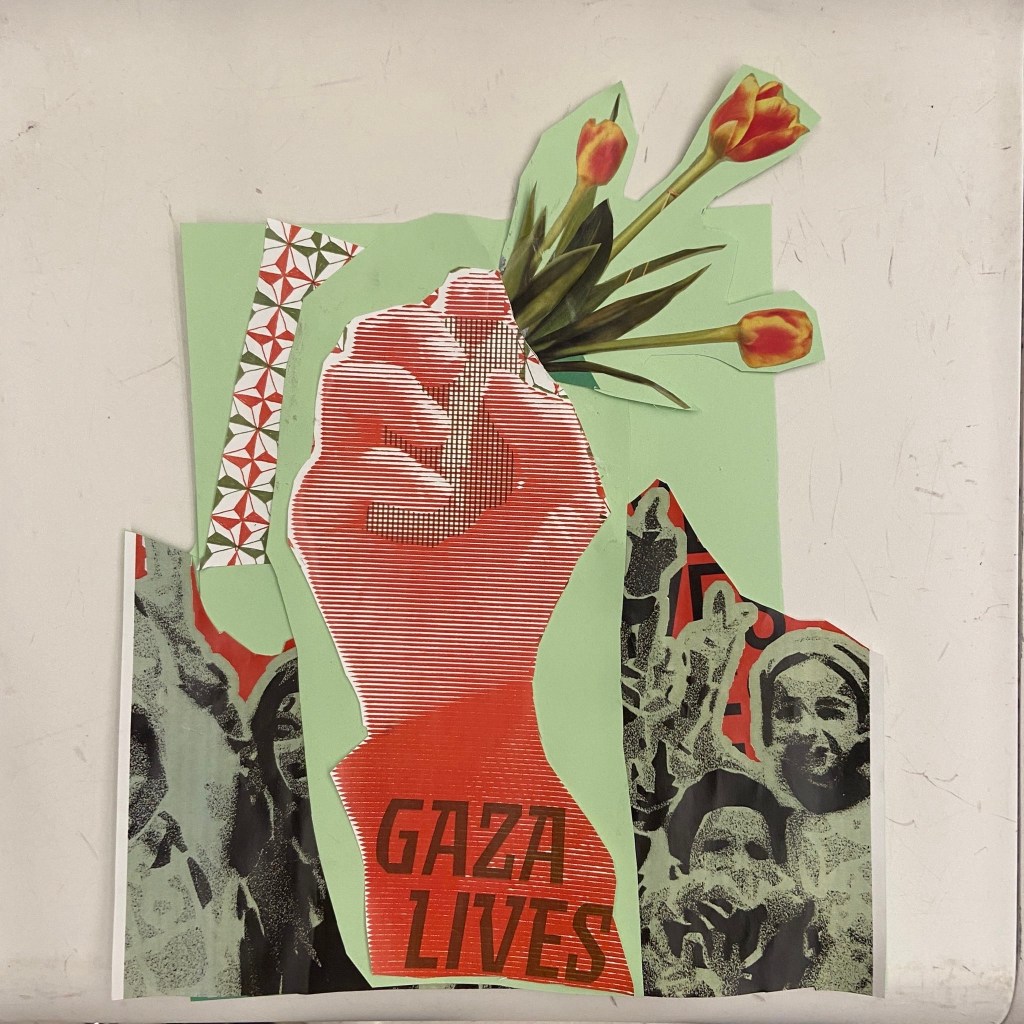
On the corner of 13th Street and Fifth Avenue, ten NYPD officers stood in a line before the entrance to The New School’s University Center. They were guarding a building that stood empty and dark, except for one or two custodians moving about the lobby.
Before the cops was a line of metal barriers used for demonstrations. In front of the barriers, a core of protesters sat on the sidewalk leading chants, banging plant potters against the sidewalk, drumming on Home Depot buckets and a tambourine.
The rally was called by student union organizers in response to the mass arrest of New School student protesters earlier that morning and was soon augmented by a march from NYU that merged with the crowd as it moved uptown. With it came an escort of more helmet-clad NYPD. When the march moved back down Fifth Avenue towards Washington Square Park, a mass of a hundred people remained at The New School. Arrested Gaza Solidarity Encampment organizers who had been released could be seen leading chants with even more fervor than before.
Across the country, for the past two weeks, we have witnessed rounds of suppression of pro-Palestinian demonstrators on college lawns and academic buildings by law enforcement, only for the masses of students to return, defy orders to disperse, and to expand their resistance. As the state of Israel inflamed the Middle East with attacks and provocations on neighboring countries, the agents of the American imperialist government have ratcheted up the jingoism of “normal” times to higher levels.
At this point, students may find it useful to take stock of the recent past, on what has happened in the sphere of student organizing, and what the pro-Palestine movement has become.
On the night of October 10, the Islamic University of Gaza was bombarded by Israel till the campus had been leveled. The ground invasion began 17 days later. In December, the IUG’s president Sufyan Tayeh was killed with his family by an Israeli airstrike on the Jabalia refugee camp, shortly before the ground offensive in southern Gaza. Demonstrations and street marches of various sizes in support of the Palestinian people took place across the globe, including the Arab world, where the Abraham Accords and the prospective Saudi normalization had been premised on an estimation that “decoupling” Palestine would have minimal political costs.
Meanwhile in the States, the Congressional Committee on Education and the Workforce began its show trial of university presidents Liz Magill of UPenn and Claudine Gay of Harvard; both resigned by early January. On February 25, a 25-year-old Air Force serviceman named Aaron Bushnell protested the war on Gaza by self-immolation outside the Israeli embassy in Washington. Two days later, “Uncommitted” won 13% of the vote in the Michigan Democratic primaries, defeating Biden outright in Dearborn with 56%.
While there have been long-running encampments and sit-ins against Israel’s genocide on campuses like Vanderbilt and Stanford, the current wave of pro-Palestine encampments was kicked off by Columbia on April 17. That same day, Columbia’s president Minouche Shafik proved even more pliable than her UPenn and Harvard counterparts during another “anti-Semitism hearing.” She willingly denounced her students and faculty under the grandstanding of Elise Stefanik. Shafik called on the NYPD to move in on Columbia’s encampment the following day.
At NYU, where Columbia’s example was followed with another solidarity encampment, 100 students and 20 faculty were arrested on the night of April 22. From NYU to Emory to Cal Poly Humboldt, a pattern has emerged of excessive provocations made by administrators, antagonizing students and faculty alike.
Footage surfaced from Arizona State University showing fraternity brothers assisting the police in destroying the solidarity encampment, breaking down and throwing away tents. This would not be the first time college frat brats and other campus reactionaries in the US have functioned as kegger-throwing Freikorps. In 1986, members of the Theta Xi fraternity at Berkeley vandalized the shanty town made in support of the South African people’s struggle against apartheid. That same year, students armed with sledgehammers attacked the anti-apartheid shanty town at Duke, tearing down the sheds and chucking the wooden debris onto a flatbed truck that had been rented by a local rightwing newspaper.
Of course, the denial of the current Palestine campus protests has been a bi-partisan endeavor. As the anti-Zionist protest movement develops over the summer, the representatives of bourgeois imperialism ensconced in the two political parties will be focused on the upcoming general election. A memo from the GOP to the Secret Service has raised concerns about the effect of protests on their party convention in Milwaukee this July. The Democrats are hosting their convention in late August in Chicago—as in 1968. Everyone is expecting a social mini-volcano.
But the centrist liberals are not publicly worried, not by the precipitous drop in Biden’s support among the youth in the polls, or the implications of excessive repression and scores of arrested students and faculty at ASU and Emory on whether or not the swing states of Arizona and Georgia will turn blue this November. They are supposing (read: vainly hoping) that the fear of former President Trump’s agenda will prompt their electorate to tighten up, and turn a blind eye on the atrocities underway in Gaza and the West Bank.
Whatever plan the Democrats had for securing the incumbent President’s second term is disintegrating before their eyes in real time. Not unrelatedly, in mid-March, Schumer called from the Senate floor for new elections in Israel, which drew rebukes from Israeli ambassador Herzog and the GOP. It remains to be seen how a growing contradiction within the party will affect their unified support for and facilitation of Israel’s campaign of genocidal destruction.

Columbia, CCNY, UT Austin—these bourgeois institutions serve capital when they repress the voice of the students, while continuing their economic attacks on the workers and faculty.
For the students, the situation has become abundantly clear. The romanticizing of the student activism of the 1960s in campus brochures reeks of hypocrisy. College administrators, boards of trustees, presidents, chief operating officers, none of them want to see a new student movement. They want us to acquiesce to Israel’s state narrative, hammered home by the Democrats in office, as well as their commercialized model of education. Over the years and decades, they cut classes, services, budgets, increased students’ instability through higher tuition and necessitating loans, while lowering their morale.
But the students, the pro-Palestinian anti-Zionist organizers, recognize that this is their moment to seize. They are holding fast to their democratic demands, while also confronting new political questions as they emerge within the camp of struggle. As they display their popular power, their readiness to struggle against the functionaries of capital and imperialism, and their sharpening political consciousness, they also indicate to the class enemy within the universities that the more these parasitic servants of finance capital take away from the students—including their sense of a better future—the more they will lose their fears. As Lucifer says in Book 4 of Milton’s Paradise Lost:
So farewell, hope; and with hope farewell, fear

